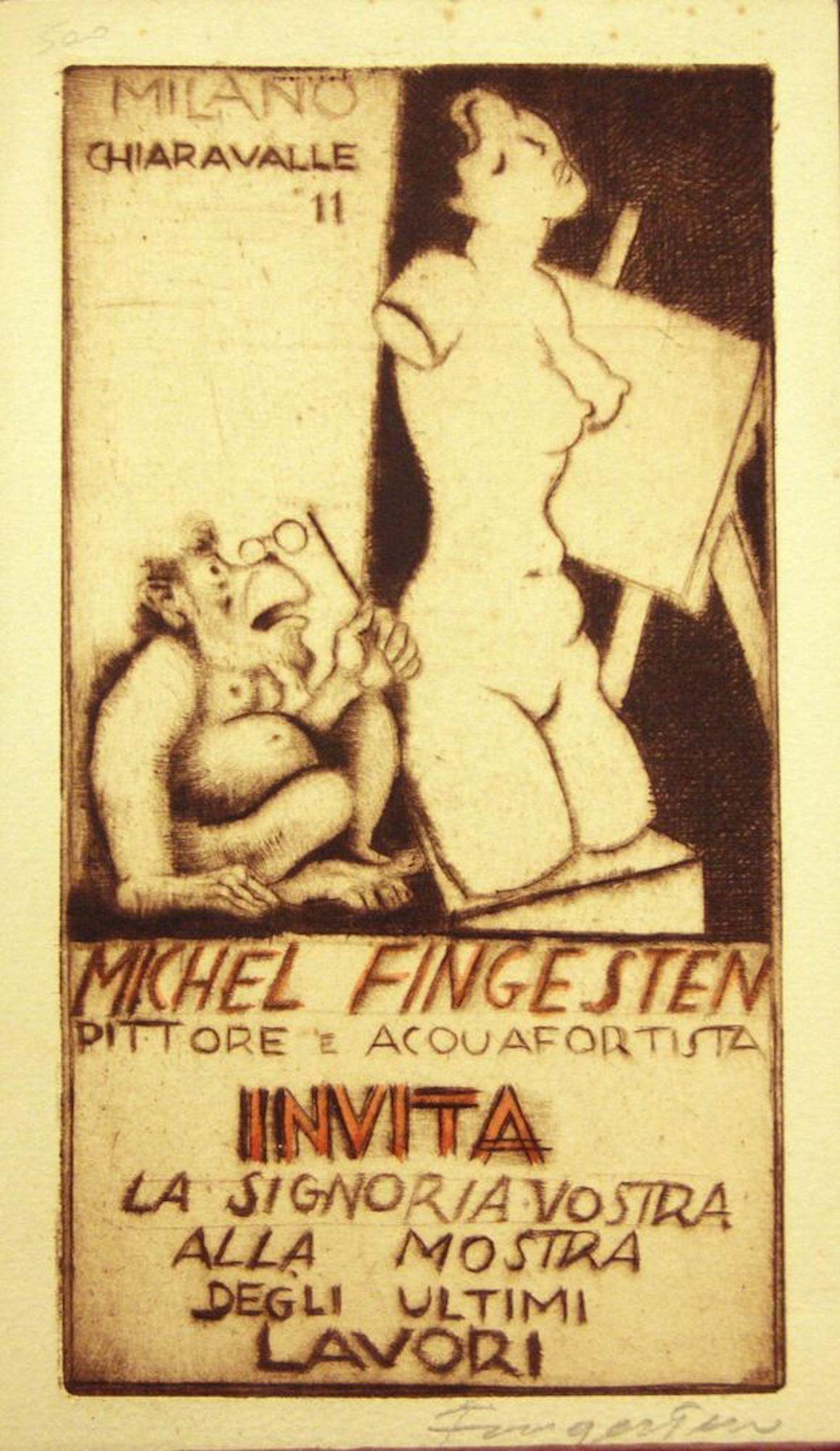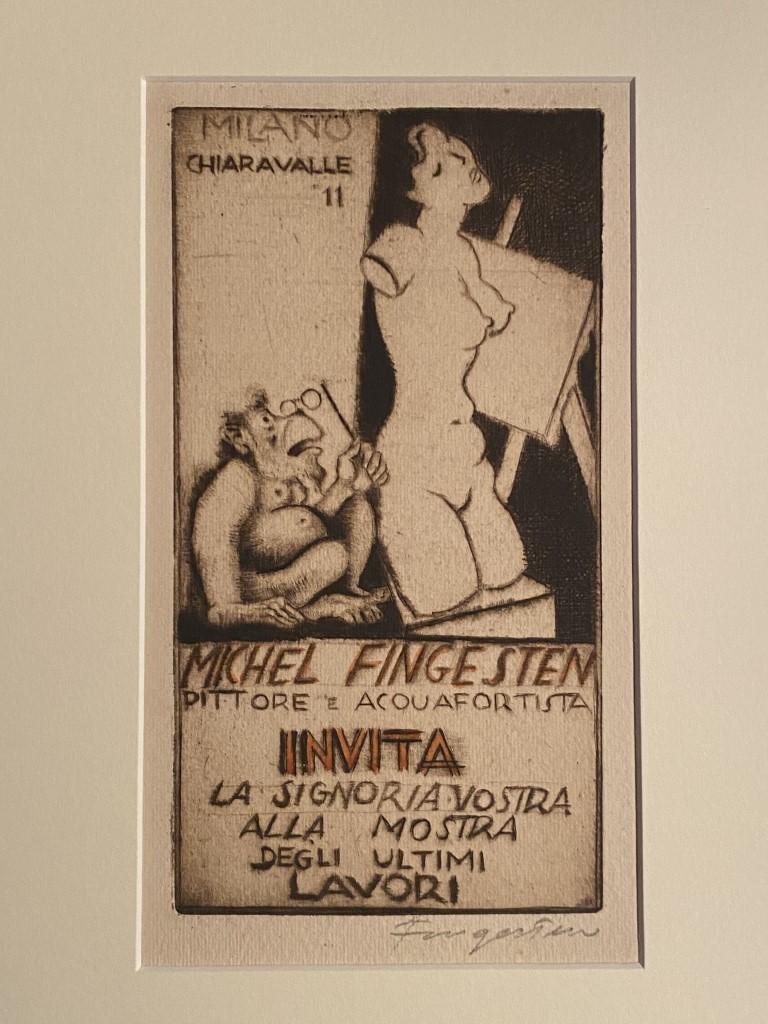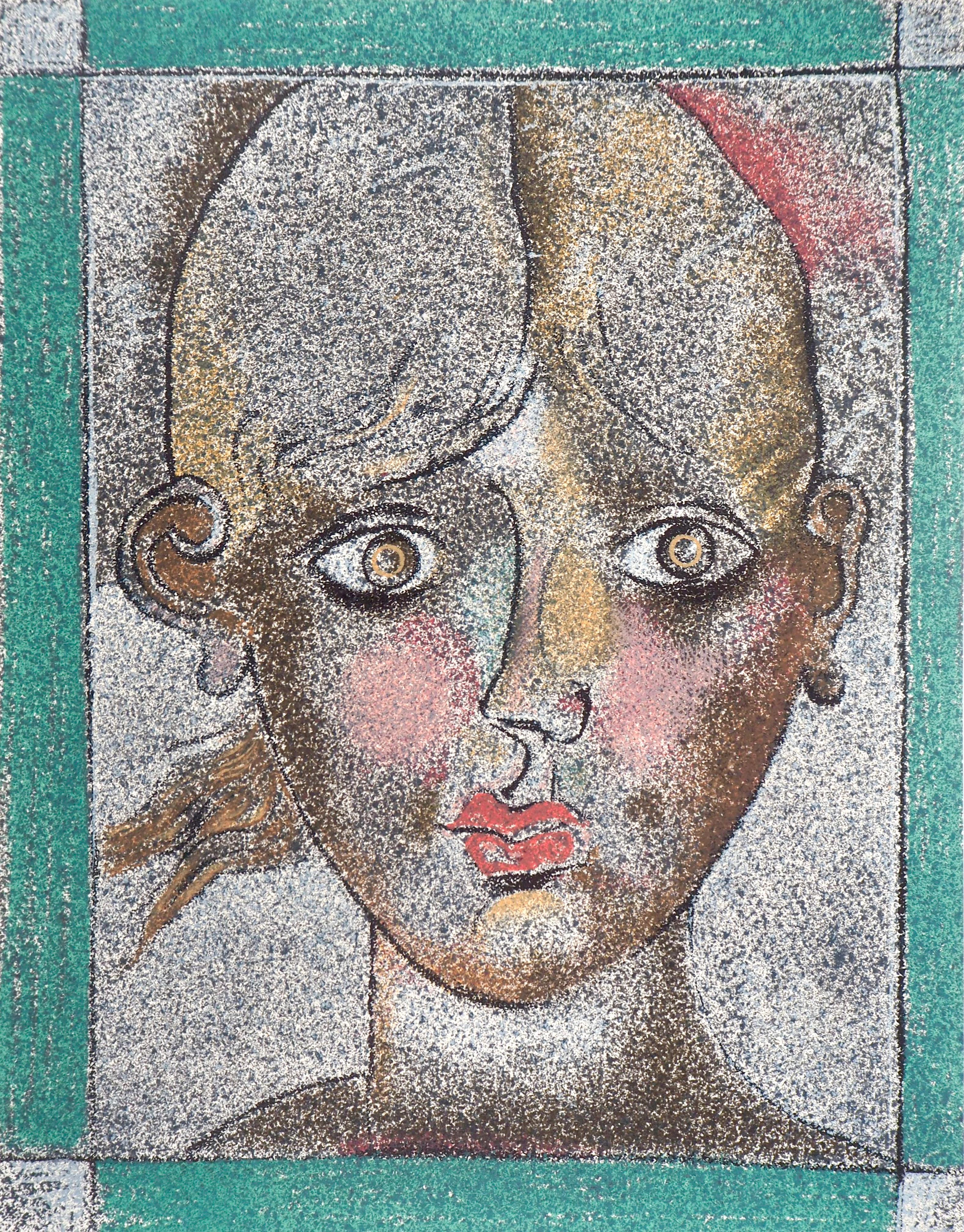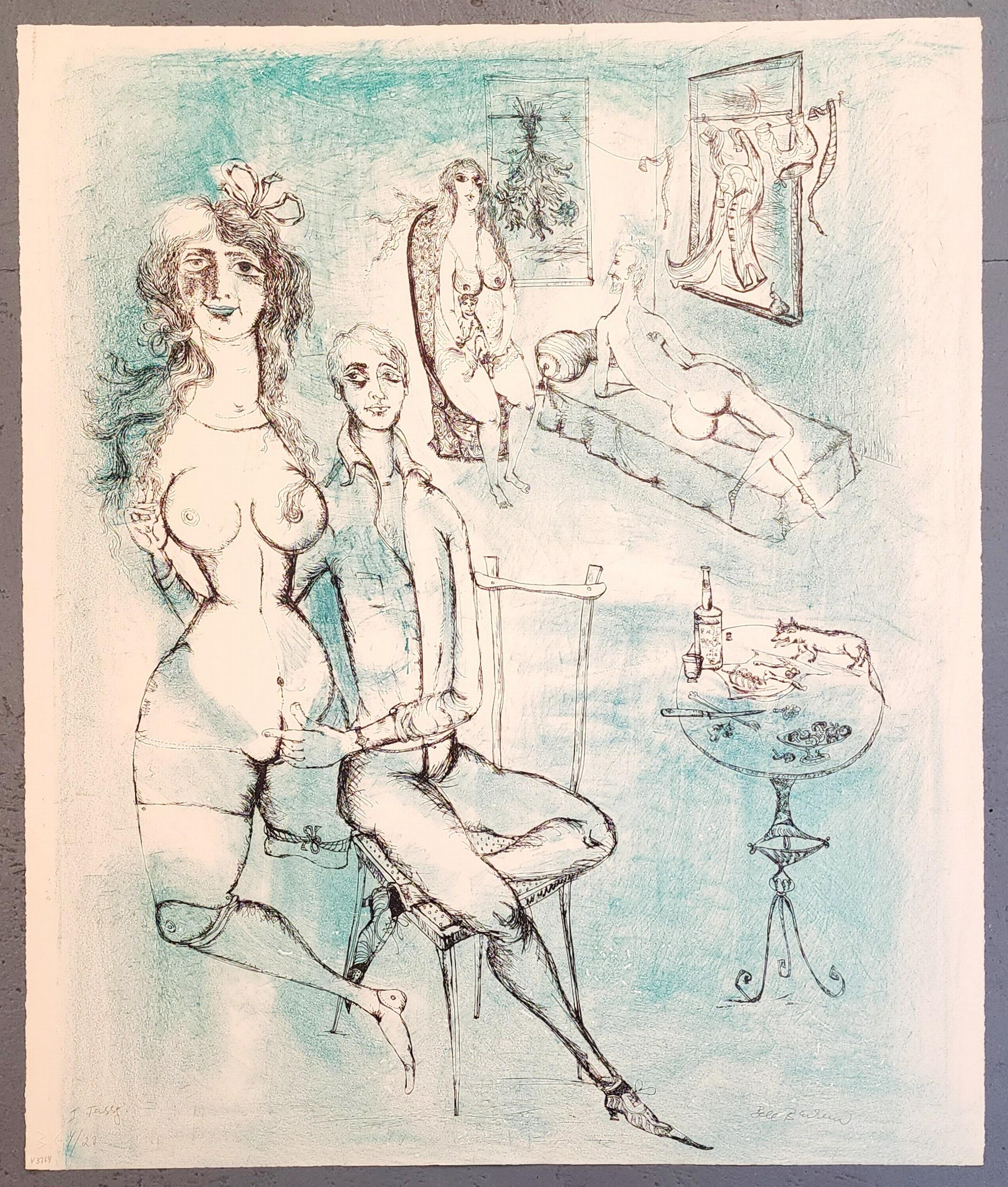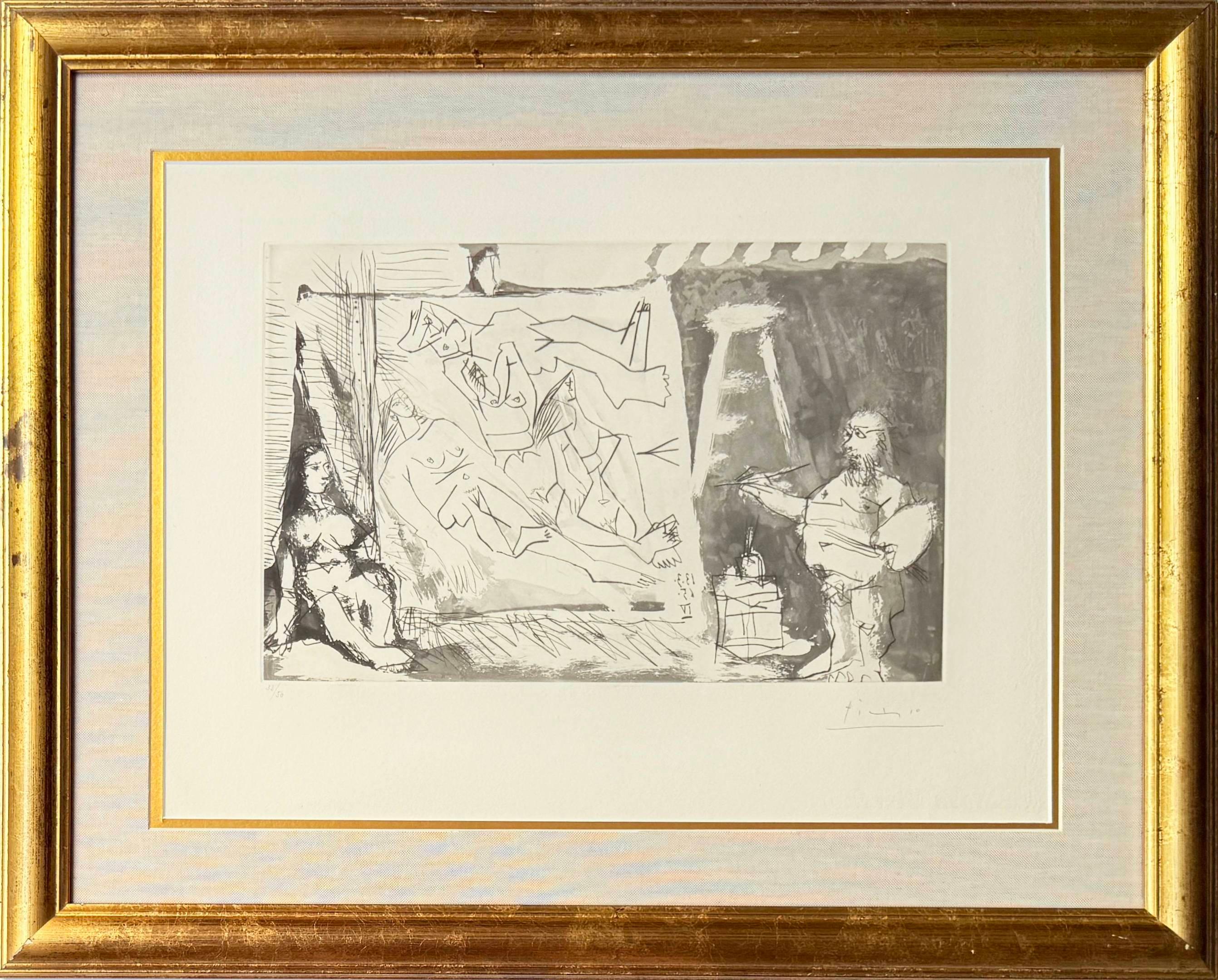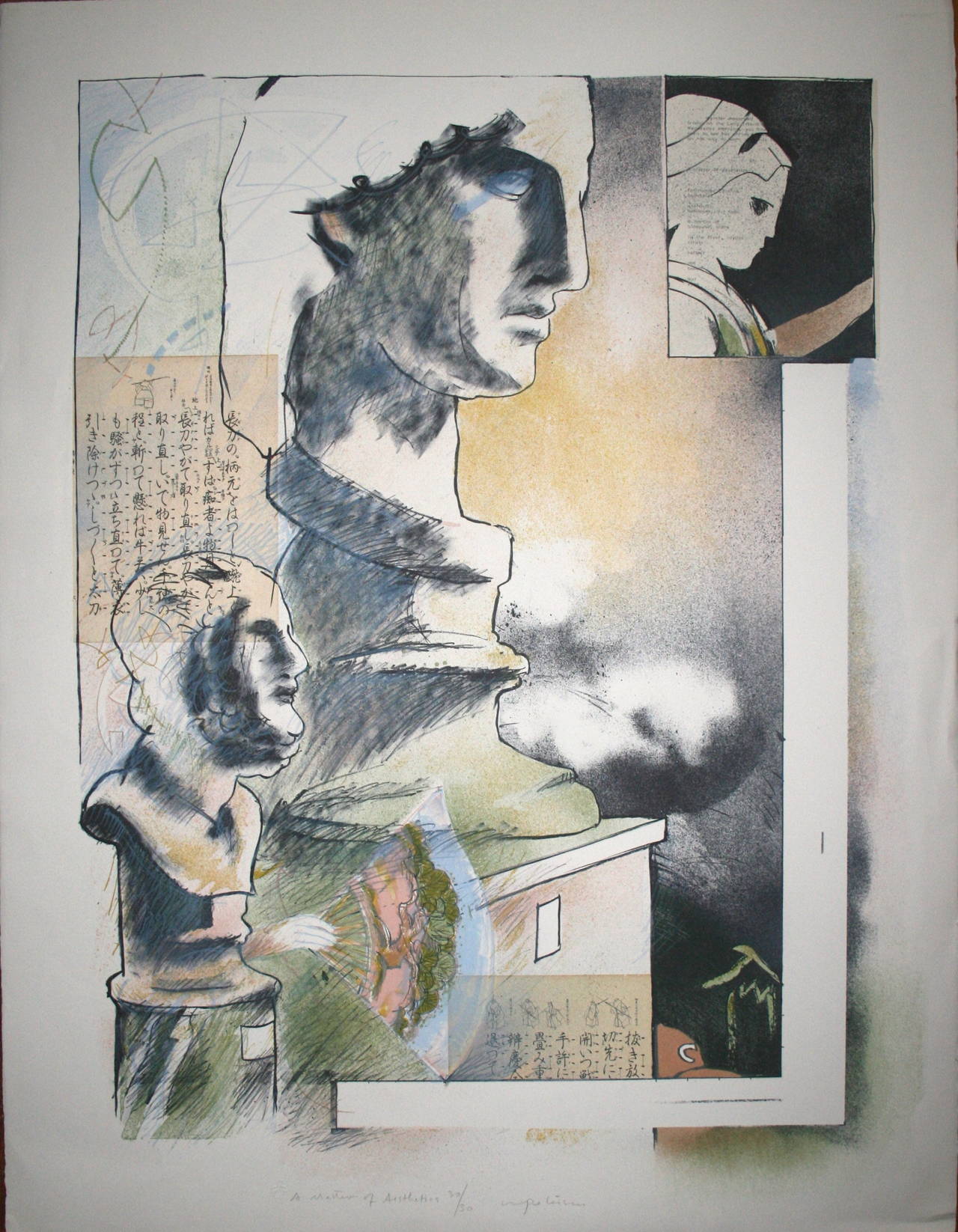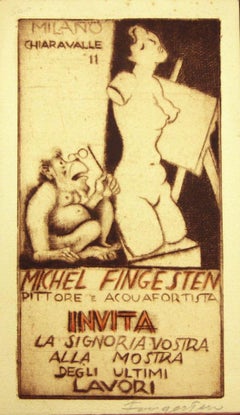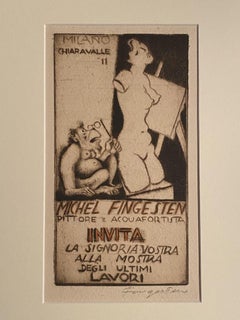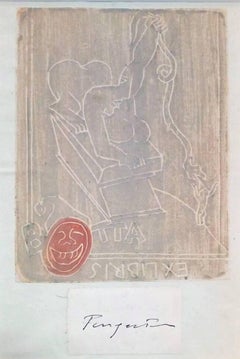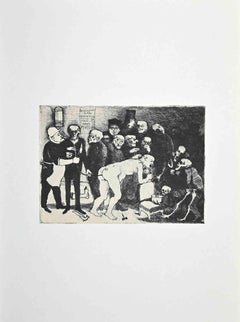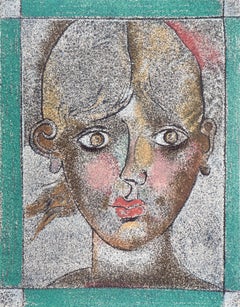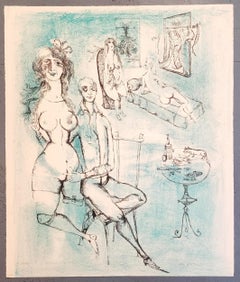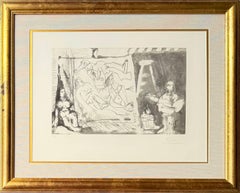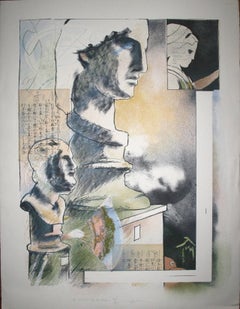Items Similar to Invitation to Your Excellency to the Exhibition of the last Artworks
Want more images or videos?
Request additional images or videos from the seller
1 of 2
Michel FingestenInvitation to Your Excellency to the Exhibition of the last ArtworksEarly 1900
Early 1900
$472.62
£358.38
€400
CA$665.30
A$726.86
CHF 380.95
MX$8,678.95
NOK 4,820.96
SEK 4,495.45
DKK 3,047.11
About the Item
Image dimensions: 19x10 cm
Original rare Ex Libris by Michel Fingesten; includes passpartout. Hand signed in pencil.
Michel Fingesten
Michel Finkelstein, known as Fingesten, was born in 1884 in Buzkovice u Ostravy; he was a painter and engraver, who was famous particularly for his extraordinary production of Ex Libris (bookplates).
After studying at the Academy of Fine Arts in Vienna, and in Monaco with Franz von Stuck, who addressed him to the caricature and to the graphics of small size, Fingesten left Austria; he travelled all over the world, visiting Europe, the United States of America and the Oriental countries.
Fingesten’s stay in Berlin since 1913 was decisive for his contact with the world of the engraving. After his adhesion to the New Secession, Fingesten destroyed his previous pictorial production and he decided to dedicate himself to the dimension of the engraving; even if he preferred the graphics, he continued to see himself as a “painter”.
The German city was characterized by a very dynamic artistic atmosphere that stimulated Fingesten. The engravings of this artist were published since 1915 in files and books in limited edition.
Fingesten’s works were published also in the famous periodicals of the expressionist avant-garde, like “Genius” and “Marsyas”, with the artists and the writers most important of his age.
Considered as a genius of the Ex Libris, that became with him a big art of small size, Fingesten realised more over than 1.500 of these brands of property since 1915. Fingesten’s Ex Libris were nourishment for the bibliophiles, who glued the bookplates on the first page of theirs books to indicate the property and who traded these Ex Libris.
The Ex Libris is a genre that doesn’t have confines and that can’t be reduced to indicate the name of the owner on the book, on which it is glued.
It left his old function of simple heraldic sign of property, and it became almost the projection of the bibliophile’s personality.
Even if he didn’t fall in the eclecticism, Michel Fingesten used generously the medium of the quote, in the subject, in the form and in the style.
In the 20s, for example, his art oscillates between Otto Dix and George Grosz, of which he overcomes the social critique and the erotism, and Karl Arnold of which he beats the irony.
The Great Depression of 1929 and the rapid advance of the Nazism contributed in a significant way to the progressive isolation of the Czech painter and engraver.
In the spring of the 1935, Fingesten left Germany and went to Italy, where he settled in Trieste and Milan.
The collector Mantero remembers about Fingesten’s Italian stay that “he lived in a home without furnitures” in Via Chiaravalle 11.
Mantero, who was one of the most important Fingesten’s customers of Ex Libris, wrote: “I understood he had a difficult and poor life for absence of money, but he didn’t have ambition of a rich life, indeed he told me that the earnings to buy some bread and a glass of wine were enough for him”.
In that period, the main means of subsistence were the commissions of the collectors of Ex Libris, especially the collectors of Milan and Como, members of the circle of friends of the art merchant Luigi Filippo Bolaffio.
Also known as “Picasso of the Ex Libris”, Fingesten explored this artistic medium and he elevated it with new and powerful expressive resources.
When the Ex Libris was detached from its practical function, the Artist began to create Ex Libris also for fake customers, for “famous contemporary people”, poets, musicians, and since 1928, for political men.
The Ex Libris, realised with a lot of graphic techniques, like the etching, the drypoint and the lithography, has always (with the graphics of occasion) the signature of the Artist, that underlines the awareness of his valour.
An important chapter of the production of this Artist was dedicated to the erotic Ex Libris, that for their irony were understood with difficulty by people that didn’t belong to the circle of the Artist.
Some of the most secret and rare erotic works by Fingesten are linked to the commissions of Gianni Mantero.
The dominant element of these engravings is the sarcasm, that is sometimes connected to a gloomy irony, and to the presence of the death, that coincided with the war, particularly in the last years of the Artist existence.
In his compositions, Fingesten was a narrator of life and death, of sex and love, of nightmares, hopes, art and poetry. His narration wasn’t without the time and the space, but it was at the center of the contemporary dimension, in the 20s and 30s of the anguished Europe that was going to the ruin.
We can underline that the relationship between the Artist and the customer had an important role in the definition of the power of these graphic works; actually the creative energy, that was born from the contact between the Artist inspiration and the customer personality, generates a strong expressive freedom.
After his death, Michel Fingesten and his works were forgotten; today there is a new attention to this very important artist and to his visionary sign.
Bibliography
• N. Nechwatal, Michel Fingesten – Das graphische Werk, Coburg 1984
• A. Tomasetig, Michel Fingesten: dalla collezione Cauti una mostra di ex libris e grafica d’occasione, 2005
• A. Parik, The unknown Michel Fingesten, Praha 2008
This artwork is shipped from Italy. Under existing legislation, any artwork in Italy created over 70 years ago by an artist who has died requires a licence for export regardless of the work’s market price. The shipping may require additional handling days to require the licence according to the final destination of the artwork.
- Creator:Michel Fingesten (1884 - 1943, Italian)
- Creation Year:Early 1900
- Dimensions:Height: 11.82 in (30 cm)Width: 9.45 in (24 cm)Depth: 0.04 in (1 mm)
- Medium:
- Movement & Style:
- Period:
- Condition:Insurance may be requested by customers as additional service, contact us for more information.
- Gallery Location:Roma, IT
- Reference Number:Seller: J-653821stDibs: LU65034670902
About the Seller
4.9
Platinum Seller
Premium sellers with a 4.7+ rating and 24-hour response times
1stDibs seller since 2017
7,825 sales on 1stDibs
Typical response time: 1 hour
- ShippingRetrieving quote...Shipping from: Roma, Italy
- Return Policy
More From This Seller
View AllBundle of 22 Ex Libris by Michel Fingesten
By Michel Fingesten
Located in Roma, IT
22 Ex Libris print by Michel Fingesten:
J-68453, Ex Musicis - Original Woodcut by M. Fingesten - Early 1900
M-109818, Ex Libris - Mantero - Original Etching by M. Fingesten - 1930s
J...
Category
Early 20th Century Modern Figurative Prints
Materials
Etching
Ex Libris - Etching by Michel Fingesten - 1930s
By Michel Fingesten
Located in Roma, IT
"Ex Libris" is an Etching, Ex Libris, on ivory-colorated paper by Michel Fingesten .
In excellent conditions: As good as new.
This artwork represents an invitation from the artist...
Category
1930s Symbolist Figurative Prints
Materials
Etching
Ex Libris "Botta"
By Michel Fingesten
Located in Roma, IT
Xilograph on paper. Signed by the artist on little cardboard sticked on paper. Very good conditions.
Includes passepartout.
Image Dimensions : 27 x 19.5 cm
Michel Fingesten (Butzkow...
Category
20th Century Modern Abstract Prints
Materials
Woodcut
Figures - Offset Print by Franco Gentilini - 1970s
By Franco Gentilini
Located in Roma, IT
Figures is a Vintage Offset Print on ivory-colored paper, realized by Franco Gentilini (Italian Painter, 1909-1981) in the 1970s.
The state of preservation of the artwork is excelle...
Category
1970s Modern Figurative Prints
Materials
Paper, Offset
Museum - Original Lithograph by Fabrizio Clerici
By Fabrizio Clerici
Located in Roma, IT
Museum is an enchanting lithograph realized by Fabrizio Clerici.
Hand-signed and numbered. Edition of XVI/XXXV prints, in roman numerals.
In excellent conditions.
The artwork rep...
Category
Mid-20th Century Modern Animal Prints
Materials
Lithograph
Vintage Poster Inter-Art-Gallery Exhibition - 1987
Located in Roma, IT
Vintage Poster Inter-Art-Galery Exhibition is a vintage poster realized in 1987, for the exhibition held at Inter Gallery.
Vintage offset and lithograph poster.
Good conditions.
Marc Chagall (Lëzna, 1887 – Saint-Paul-de-Vence, 1985). Chagall was a Russian-French artist of Belarusian Jewish origin. An early modernist, he was associated with several major artistic styles and created works in a wide range of artistic formats, including painting, drawings, book illustrations, stained glass, stage sets, ceramics, tapestries and fine art prints. Before World War I, he travelled between Saint Petersburg, Paris, and Berlin. During this period he created his own mixture and style of modern art based on his idea of Eastern Europe and Jewish folk...
Category
1980s Contemporary Figurative Prints
Materials
Offset
You May Also Like
Franco Gentilini, Head of a Young Girl, from XXe siecle, 1978
By Franco Gentilini
Located in Southampton, NY
This exquisite lithograph by Franco Gentilini (1909–1981), titled Testa di fanciulla (Head of a Young Girl), from the album XXe siecle, Nouvelle serie, XL Annee, No. 50, originates f...
Category
1970s Contemporary Figurative Prints
Materials
Lithograph
$716 Sale Price
20% Off
Free Shipping
Sanft bis zur letzten Rasur (I. Fassung)
Located in Kansas City, MO
Bele Bachem
Sanft bis zur letzten Rasur (I. Fassung)
Lithograph on Velum
Year: 1968
Size: 30x25.1 inches
Signed, dated and inscribed by hand
Dry Stamp lowe...
Category
1960s Modern Figurative Prints
Materials
Vellum, Lithograph
$422 Sale Price
38% Off
Dans l'Atelier
By Pablo Picasso
Located in OPOLE, PL
Pablo Picasso (1881-1973) - Dans l'Atelier
Etching and aquatint from 1965.
The edition of 33/50.
Dimensions of work: 39 x 51.5 cm.
Hand signed.
Publisher: Galerie Louise Leiris,...
Category
1960s Modern Figurative Prints
Materials
Etching, Aquatint
A Matter of Aesthetics
Located in Surfside, FL
Lithograph with Roman portrait bust.
Will Petersen, a painter, master printer and a poet, was born in
Chicago. (Amer. 1928-1994) created this limited edition LITHOGRAPH at
the Lakeside Studio.
The LITHOGRAPH PRINT is from a limited edition THE LITHOGRAPH IS SIGNED TITLED AND ANNOTATED
BY THE ARTIST in pencil EXCELLENT condition.
Will's formal art education began with classes at the Chicago Academy
of Fine Arts. As a student at the city's Steinmetz High School,
Petersen succeeded Hugh Hefner (of Playboy magazine fame) as the HS
newspaper cartoonist, the Steinmetz Star. During this time, Petersen
recovered from polio.
In 1947 Petersen enrolled at Chicago's Wilbur Wright College. While
there, he painted with oils for the first time. Two years later he
enrolled at Michigan State University where he developed a strong
interest in literature and writing and began printmaking. By 1951 he
had begun to exhibit paintings and prints nationally. A year later he
completed his master's degree.
Petersen served in the United States Army from 1952-54, spending one
year as an education specialist in Japan. This encounter with the
Japanese culture affected his entire life. He became interested in
calligraphy and Noh, classical Japanese Buddhist performance that
combines elements of drama, music and poetry. Upon completion of his
military service in Japan in 1955, Will Petersen settled in Oakland,
California, where he met some of the most active poets of the Beat
Generation: Gary Snyder, Allen Ginsberg, Jack Kerouac, Phil Whalen,
Mike McClure and others. Petersen was attracted to the group by their
intelligence and belief in Zen Buddhism.
In 1956 in his small studio in Oakland, he printed the poems of Jack
Kerouac. He attended for the first time, the reading of Ginsberg's
Howl at Six Gallery. His relationship with Gary Snyder had begun when
both were in Kyoto, Japan; later Snyder wrote for the Plucked Chicken.
Petersen returned to Japan in 1957, pursuing painting, printmaking and
writing for eight years while living in Kyoto. In 1965 he accepted a
faculty appointment at Ohio State University, teaching drawing,
painting and printmaking. Four years later Petersen took his teaching
skills to West Virginia University in Morgantown, where he
concentrated on printmaking. He taught there until 1977 when he began
publishing Plucked Chicken, a journal of art and poetry. In 1978 in
Morgantown, Petersen and his wife, Cynthia Archer, established Plucked
Chicken Press, which they later moved to Chicago and then Evanston.
Petersen operated the Press until his death on April 1, 1994.
1956 In storefront studio in Oakland, California, creates serigraphs
and lithographs. Prints poems of Jack Kerouac.
1961 Back in Japan, acquires a lithography press and stones and
resumes printing lithographs. Exhibits regularly with Kyoto
Printmakers.
1969 Resident lithographer at the Lakeside Studio, Lakeside, Michigan.
Prints for the first time Richard Hunt lithographs.
1978 Establishes Plucked Chicken Press in Morgantown, West Virginia.
Resident lithographer at Lakeside Studio in Michigan.
1980 Plucked Chicken Press moves to Chicago. Publishes lithographs by
Don Crouch and Art Kleinman.
1982 Publishes Blossom, a lithograph/collage by Tom Nakashima.
1983 Series I of Plucked Chicken Press is published with work by
Archer, Duckworth, Godfrey, Heagstedt, Himmelfarb, Hoff, Hunt, Martyl,
Miller, Nakashima and Petersen.
1984 Plucked Chicken Press moves to Evanston. Series II of Plucked
Chicken Press is published with works by Croydon, Ho, Archer, Torn,
Osver, Middaugh, Roseberry, Petersen, Spiess-Ferris and Hoppock.
1985 Series III of Plucked Chicken Press is published with works by
Driesbach, Hunt, Trupp, Gregor, Pattison, Conger, Evans, Weygandt,
Archer, Ho and Petersen. Prints Suite I, Northern Illinois University
Collectors Series, with lithographs by Renie Adams, David Bower, David
Driesbach, Carl Hayano and Ben Mahmoud...
Category
1980s Modern Figurative Prints
Materials
Lithograph
Gallery
By Moshe Chauski
Located in Toronto, ON
8" x 10" Unframed
Limited Edition Etching of 69
Hand Signed by Chauski
Category
21st Century and Contemporary Figurative Prints
Materials
Etching
Franco Gentilini, Page’s Head, from XXe siecle, 1980
By Franco Gentilini
Located in Southampton, NY
This exquisite lithograph by Franco Gentilini (1909–1981), titled Testa di paggio (Page’s Head), from the album XXe siecle, Nouvelle serie, XLIIe Annee, No. 55, originates from the 1...
Category
1980s Contemporary Figurative Prints
Materials
Lithograph
$716 Sale Price
20% Off
Free Shipping
